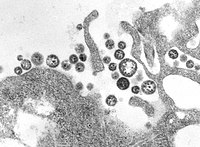
Photo from wikipedia
Human immune system (HIS) mice are a subset of humanized mice that are generated by xenoengraftment of human immune cells or tissues and/or their progenitors into immunodeficient mice. Viral hemorrhagic… Click to show full abstract
Human immune system (HIS) mice are a subset of humanized mice that are generated by xenoengraftment of human immune cells or tissues and/or their progenitors into immunodeficient mice. Viral hemorrhagic fevers (VHFs) cause severe disease in humans, typically with high case fatality rates. HIS mouse studies have been performed to investigate the pathogenesis and immune responses to VHFs that must be handled in high-containment laboratory facilities. Here, we summarize studies on filoviruses, nairoviruses, phenuiviruses, and hantaviruses, and discuss the knowledge gained from using various HIS mouse models. Furthermore, we discuss the complexities of designing and interpreting studies utilizing HIS mice while highlighting additional questions about VHFs that can still be addressed using HIS mouse models.
Journal Title: Vaccines
Year Published: 2020
Link to full text (if available)
Share on Social Media: Sign Up to like & get
recommendations!